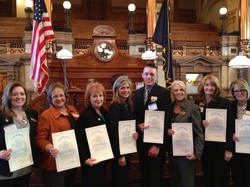 Recognition with Senate Resolution No. 1705 This past week, the 2013 Kansas Teacher of the Year Team was invited to Topeka for Legislative Recognition Day. We were invited to visit the Senate Chambers and were recognized with Senate Resolution No. 1705 and met with some personalized commendations from the Senator from our respective district in the state of Kansas. Prior to that, we were invited to give some brief remarks at the joint committee meeting of the Senate's and House's Education Committee. My remarks are included below in italics.
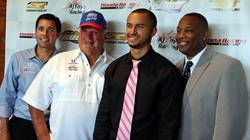 Chase Austin (pink tie) with his dad and A.J. Foyt Hello, my name is Scott Keltner and I am a high school math teacher in Eudora. I appreciate the time you have dedicated to allow us to meet with you today. I am Kansan, through and through, by way of Emporia State University and Cowley County Community College, back to my upbringing in Medicine Lodge.
All through my childhood, though, NASCAR had little to do with my life.
But that first week of student-teaching, it became obvious that I would not survive class on Monday morning without knowing who won the race on Sunday afternoon.
That’s also when I discovered it would be necessary to make math relate to my students, that relying heavily on dry lessons from a textbook would not suit my constituents, especially in the class I taught with a female student who insisted on being called Bubba.
I designed lessons to incorporate racing terminology, strategies, techniques and puns to please the audience. The students loved it and didn’t even realize they were doing math, thinking they were only talkin’ ‘bout racin’, roughly a decade before the Common Core came about.
My second year of teaching in Eudora, I had a student who was gone numerous times because of his racing talents. This year, he will actually be driving in the Indianapolis 500 for A.J. Foyt Racing in the number 41 car. His name is Chase Austin and I hope you take note of his efforts. The bond that he and I formed still persists, as he comes to visit my classroom whenever he is back in town.
I tell Chase how I am teaching a particular topic and he refers back to the way I taught when he was a student, asking why I changed the way I teach it. As Chase can attest, not every race can be driven the same way. The same thing goes in education, as a teacher strives to tailor-make a lesson to the students from one year to the next. A lot has changed in education since No Child Left Behind was instituted when Chase was a middle school student.
He also points out the new technology I have in the classroom since the days he was there. The graphing calculators he used in my classroom (at which time, I pull out an old TI-86 from my pocket) were traded away for an upgrade (at which time, I pull out a TI-84 Plus from my pocket) but at no out-of-pocket cost to our school district. Now those have been upgraded to yet another version (at which time, I pull out a TI-Nspire CX CAS from my pocket, greeted with chuckles from the legislators) still at no direct cost to our district. The SMART Board on the wall of my classroom has a similar story (I'll elaborate on that story another time), making my classroom look like a collection of tech-y garage sale finds. There are numerous opportunities available through the use of technology in the classroom, and we must secure access to these tools to see that our students are Career and College Ready and able to utilize their specific skill set towards a successful future.
 Flat Ridge Wind Farm, near my hometown in Kansas. With the passage of items like Senate Bill 155, the Career and Technical Education Law, Kansas teachers and students are able to prepare a workforce ready and able to tackle the next big opportunity that arises, helping elevate Kansas to heights greater than the mammoth wind turbines that dot the Kansas skyline now and into the future.
So, with continued support for bills like the Career and Technical Education Law and helping schools utilize technology tools to create a Twenty-First Century Classroom, we can ensure that Kansas students will remain in the race instead of stuck at a pit stop, watching others pass them by. Kansas kids and Kansas teachers deserve that opportunity to provide for the future successes of our state.
A successful race isn’t won solely by the driver. There are a lot of people that helped get to a winning position. The fact of the matter is, we’re all in this race together.
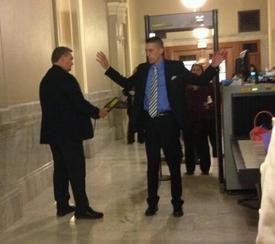 Yup, the only one of the group to get stopped by security. I was able to meet up with several legislators after our time during their committee meeting. I have to say, it's pretty nice to have that many people in an authoritative position seeking out what you are doing in a classroom, commending the work you do, or just asking your opinion on how the Common Core State Standards will affect your classroom instruction. I think both them and I were glad that most of the people in the Capitol Building were wearing name tags, though. If I'm going to do any name-dropping, though, I feel obligated to acknowledge the warm welcome I received from Senator Tom Holland from my home district. I'm not sure that even he could have helped me out in getting through Capitol Security entering the building, though. I set off the metal detector twice, then "got the wand." One of my fellow Teacher of the Year Team members snapped the photo at left. In the end, I made it in the building and our Team was even invited into Governor Sam Brownback's office for a conversation with him on what it is like to be governor, how often he speaks with President Obama, and he reciprocated by seeking out our opinions on a number of issues he is currently faced with at the state level. I am looking forward to the other opportunities that are up and coming for the Kansas Teacher of the Year Team (check out our schedule of appearances HERE), but realizing all too quickly just how big our state is. I'm looking to check out some sort of "Learn Spanish" on CD-- or "Sooo, You Wanna Learn To Speak Canadian, Eh?"--so I have something to listen to along all the miles we log through this entire experience. Any help out there--I mean, OOOT there? --Keltner-- One last note: I referenced auto racing several times throughout this post and how it relates to my students, namely Chase Austin because I taught him. Did you also realize that NASCAR driver Clint Bowyer is from Emporia, Kansas? It was to hear several funny stories about Clint from his former teachers when we toured the Emporia School District this past Wednesday, Jan. 23rd.
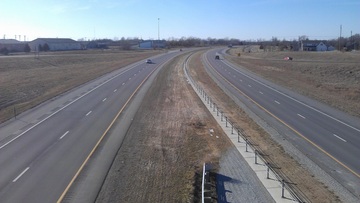 A view overlooking Kansas Highway 10 through my town. Give them something they can relate to in real life, right? Well, quadratic functions have numerous applications (most noteably Dan Meyer's basketball shot example using the 3-Act structure) but some are a stretch of the imagination for most algebra students. I don't think I knocked one out of the park on this activity, by any means, but it definitely had students engaged and talking. To elaborate on the picture at the left, our town is working on a grant application through the Kansas Department of Transportation to install a pedestrian bridge over Kansas Highway 10 and seeking community support for the project. You'll understand why this pedestrian bridge relates to the lesson shortly, I swear.
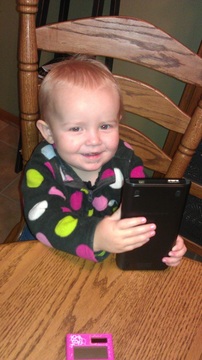 My 2-year old daughter & TI-Nspire CX. I used the TI-Nspire CX handhelds available to my classroom and was able to import pictures of objects that stressed the properties of quadratic functions in standard, vertex, and intercept forms each with a different context that I felt emphasized the form students were focusing on. (The .tns file for the activity can be downloaded HERE) Standard formThe y = a*x^2 + b*x + c form (yes, this post is letting me see how little formatting I can do with text on my blog), is where our focus began in our quadratics unit. I related this form to the path seen in Angry Birds (shown in the screenshot album below) since the path of the previous shot was visible on screen. I set up sliders to allow students to modify values of a, b, and c and watched them try to map the previous shot they saw. Some comments I heard: - "Dude, you gotta change c so it's your y-intercept to put the bird in the slingshot!"
- "Yeah, a has to be negative so it's concave down, but make it barely negative so the graph gets wider! Duh!"
- "Whoa, changing the value of b only swivels the graph from side-to-side!" (this was important as we worked later in the unit to factor quadratics)
Most importantly, students were able to connect each constant (a, b, and c) to its unique impact on the shape of the graph, on their own terms--I just used Angry Birds to facilitate the process. The students carried their momentum into Vertex form next. Vertex formThe y = a*(x - h)^2 + k form, where the vertex is located at (h, k) was a fitting place for me to use Dan Meyer's basketball shot example , because students thus far were struggling with the idea of why symmetry was important in quadratics. They had already aced the idea of wider/narrower graphs and how that was critical to the graph's shape, but I used this to emphasize how each point on one side of the vertex also "secretly" corresponded to another point on the opposite side of the vertex. Intercept formThe y = a * (x - p) * (x - q) form that is shown many different ways in many different textbooks. This was going to be the grand finale, bringing in the pedestrian bridge project I'd mentioned earlier (the public information presentation can be found HERE, if you want to know more). I included an example photo of a pedestrian bridge in our state (over Kansas Highway 61 in Hutchinson) and students fit the graph by noting the x-intercepts on the scale that was overlaid on the photo. (Side note: they could also manually enter a value for the constants, they did not need to manually adjust values as small as shown). Several students also asked about why the towers at each side of the pedestrian bridge had to be so tall, which led us into a side discussion about height clearance and its importance to road traffic that would travel beneath (a decent review of inequalities).
So, as I was arriving at school the day after doing this lesson, the school secretary told me how cool it was to hear about my lesson at the Site Council meeting the night before. Apparently, my principal talked up the lesson during the public informational meeting THAT night in front of city administrator and some other city staff involved in the project, as well as numerous citizens in attendance. So, I received a couple emails that next day from several people expressing their thanks for having beefed up support for the project while also teaching the concept of the bridge in class. It's fun to have those "I wish my math teacher did things the way you do" moments, with the idea that parents who were at that meeting probably gave their students a pop quiz when they got home without my prompting. Sorry about that, kids. I'd mentioned a link for the TI-Nspire activity earlier, but HERE it is again if you want to use it or modify it for your own use. Even if you don't have a TI-Nspire handheld, you can give it a test-drive using the TI-Nspire Document Player HERE (open the Doc Player first, then download the activity and open it through the Doc Player interface). --Keltner--
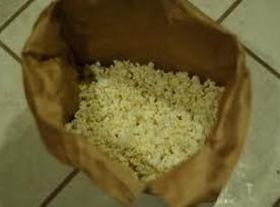 Grandma made PLENTY of popcorn when we visited. Consider this example, that might very well appear in a math textbook:
How long would you leave a $50 investment in a bank, with 2% interest, compounded annually, to yield a balance of $500?
Applicable, yes, but how enticing is it, really?
My grandmother passed away several years ago, and I miss her plenty. I'm certain my daughters would have enjoyed meeting her and hearing some of her stories, too. Or the way she could teach a new card game almost every time I went to visit her.
One of my favorite memories of visiting Grandma's house was how she would make enough popcorn to fill half a paper grocery bag, then keep it warm in her stove. And she was always generous in using salt on her popcorn, which I consider an extra perk.
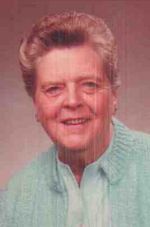 Grandma What really got me thinking, though, was when my parents told me they had found some savings bonds at Grandma's house and bank that were in my name, dating back to just after my birth. Grandma never brought it up to me, nor did she bring it up to my parents. This generous act on her part gives rise to the name of my blog: Good for Nothing (see blog post HERE about the relevance of the name). Grandma made a grand gesture with no expectation of recognition or grand reward in return. She truly did something good, for nothing in return. The math teacher in me can't leave this alone though. Knowing the end balance of these savings bonds' values, I'm curious about what the interest rate was, but realize that Grandma kept adding to the collection of bonds, which would make this more of a recursive function. Nevertheless, I greatly appreciate her generosity, even long after she left this world. It definitely makes for a great Act 1 in the 3-Act lesson format, and I'd love to figure out how to get through Act 2 to find the result in Act 3, but am uncertain as to where to go next. This might be a better example to leave to rest though. Take a moment with your Grandma next time you are with her. She just might bless you with this sort of curiosity someday like mine did. --Keltner--
|






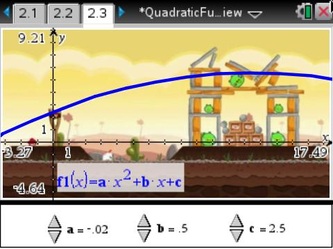
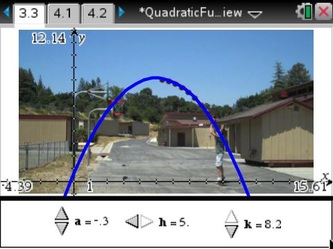
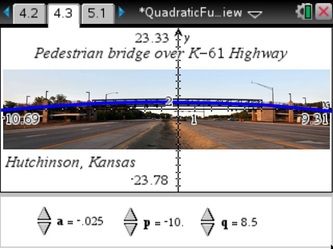
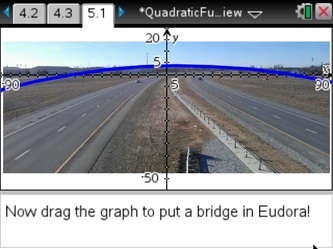
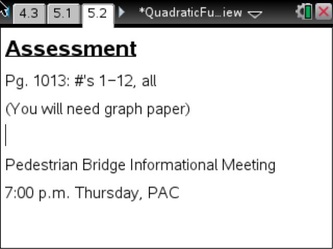


 RSS Feed
RSS Feed